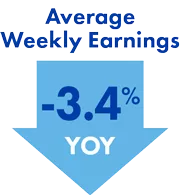October Economic Commentary: Economic slowdown becomes more evident

Chief Economist
Pohlad Companies
As each month goes by, the economic slowdown that started in the first quarter of 2022 becomes more evident in more sectors of the economy. Albeit a lagging indicator, elevated inflation is keeping the Fed focused on tightening financial conditions in order to slow demand growth. The Fed Funds rate has now been increased a full 3% since the beginning of the year, and the ongoing reduction of the Fed’s balance sheet is reducing liquidity in the economy and in markets.
Consumer Metrics
The Consumer Price Index for August, released in mid-September, increased 8.3% year over year. While down from the July reading of 8.5%, it remains elevated and was higher than expected. Drawing most attention was the increase in the core CPI (excluding food and energy), which was up 0.6%, twice the forecast amount, resulting in a year-over-year figure of 6.3%, up from 5.9% in July. The shelter component comprises 41% of core CPI and is providing the most upward pressure on this metric. Although rents are starting to ease, their impact is not likely to feed through to weaker core inflation until next year.
Disposable personal income adjusted for inflation has been negative on a year-over-year basis for nine consecutive months. This has caused consumers to lower their savings rate to the lowest level since 2008. This magnitude of contraction in savings suggests that slower consumer spending is likely to continue for the foreseeable future.
Economic Indicators
Final figures for second-quarter economic growth showed that real GDP declined at a 1% annual rate in the first half of 2022. The decline in real GDP was driven primarily by a decline in real private domestic purchases from 6.7% last year to a 1.3% annualized rate in the first half of this year.
On October 5, OPEC announced its decision to cut oil production quotas by 2 million barrels per day (bpd) from 43.9 million bpd to 41.9 bpd. More than a political move to keep energy prices high, it reflects declining demand for oil as the global economy slows. Increased energy prices will only slow the decline in overall inflationary pressures.
Leading economic indicators for August fell for the sixth consecutive month and, as such, are forecasting an upcoming recession.

Labor and Housing
The employment report for September showed non-farm payrolls slowing for the second consecutive month. Payrolls increased 263,000, down from the 315,000 increase in August. The labor force declined by 57,000 which caused the unemployment rate to decline to 3.5%, matching the pre-pandemic low. Average hourly earnings slowed to a 4.4% annual rate in third quarter, down from 4.6% in second quarter. Adjusted for inflation, average weekly earnings have been flat or negative in 9 of the past 11 months and are -3.4% year over year.
The slowdown in the labor market was also highlighted by the 1.1 million decline in job openings, according to the August Job Openings and Labor Turnover Survey (JOLTS). Job openings have dropped in four of the past five months. The ratio of job openings to unemployed persons has declined from 2.0 to 1.7.
Housing is bearing the brunt of the increase in interest rates so far. Mortgage rates have doubled this year, and housing prices have started to decline. Not surprisingly, mortgage applications for purchases are down 37% from year-ago levels.
Fed Funds
In the face of these slowing economic reports, the Fed raised the Fed Funds rate by 75 basis points (bp) at their September 21 meeting to 3.25%, and markets are expecting another 1.25% total increase in the rate by the end of the year coming from their November and December meetings. Interest rates are at decade-high levels and the 2-year to 10-year portion of the yield curve is inverted by the greatest degree since the early 1980s. Banks are also tightening their lending standards for almost all categories of loans. The availability of credit is declining, and its price is increasing. All of this points to slower economic growth.
The Fed has made it clear that they intend to keep monetary policy in a restrictive mode until they are confident that inflation is moving back toward their target of 2%. The Fed is tightening monetary policy in an economy that is already weakening, and since the full impact of the Fed actions take 12-18 months to work their way through the economy, a recession in 2023 is highly likely.
Insights
Research to help you make knowledgeable investment decisions